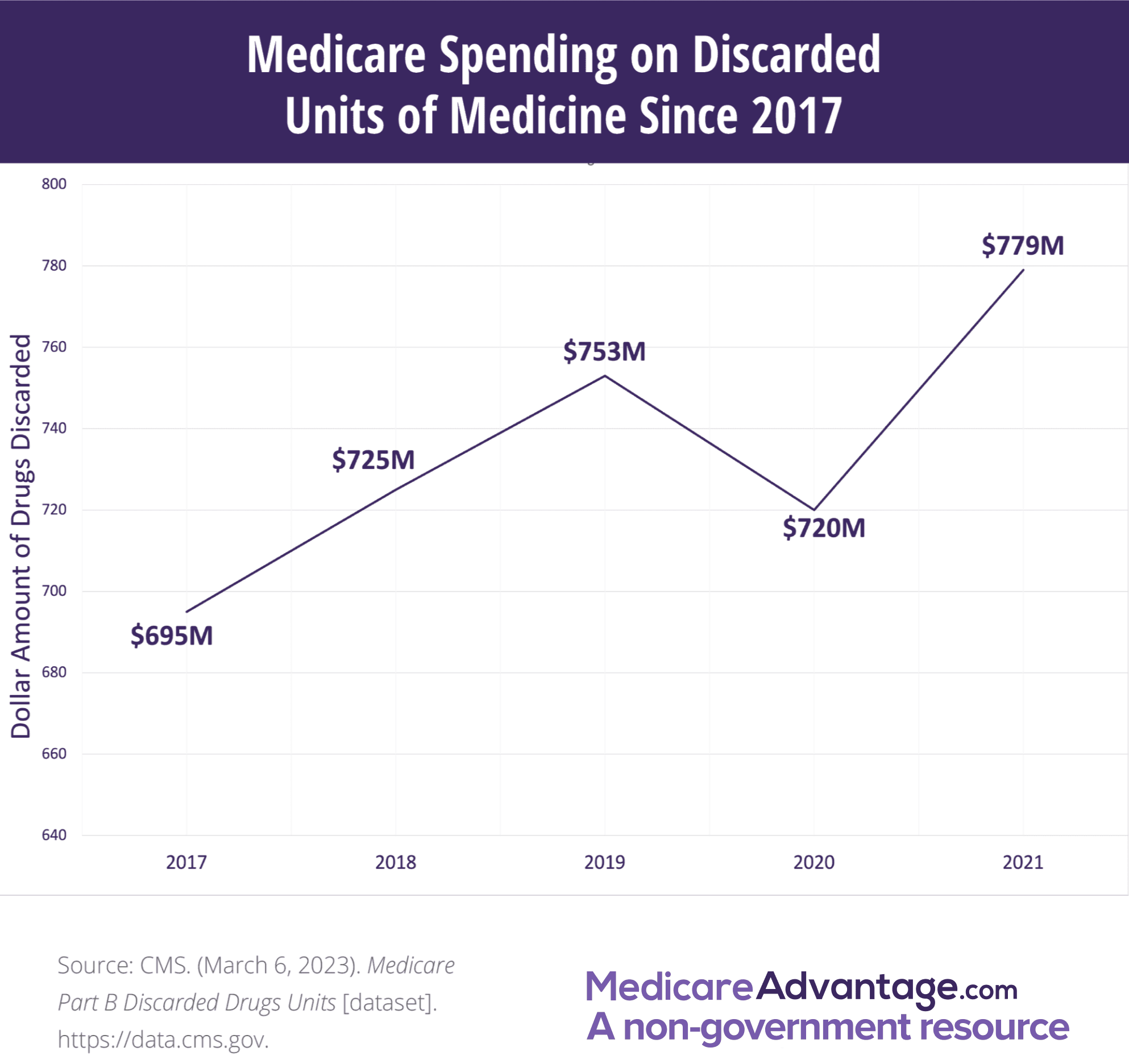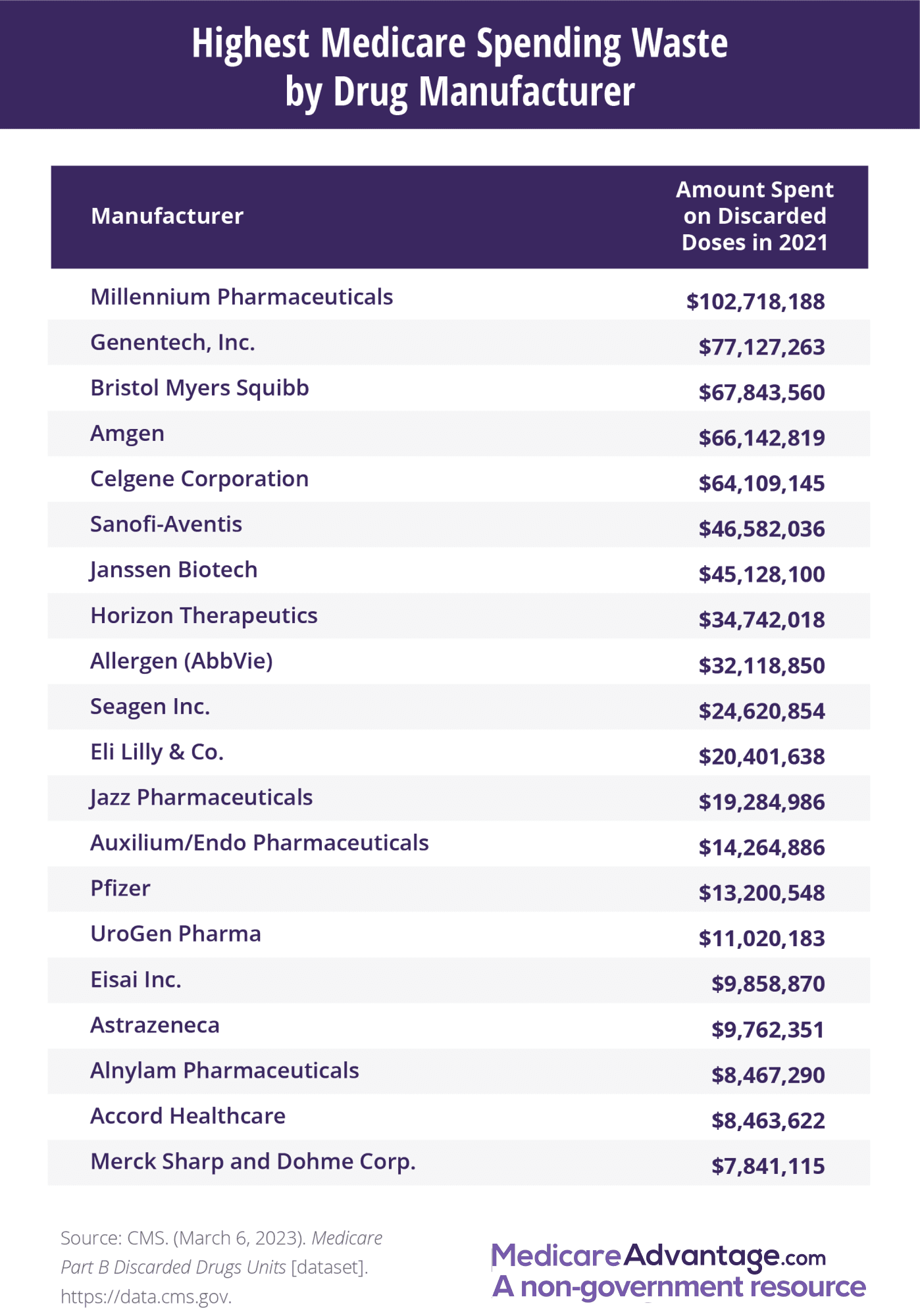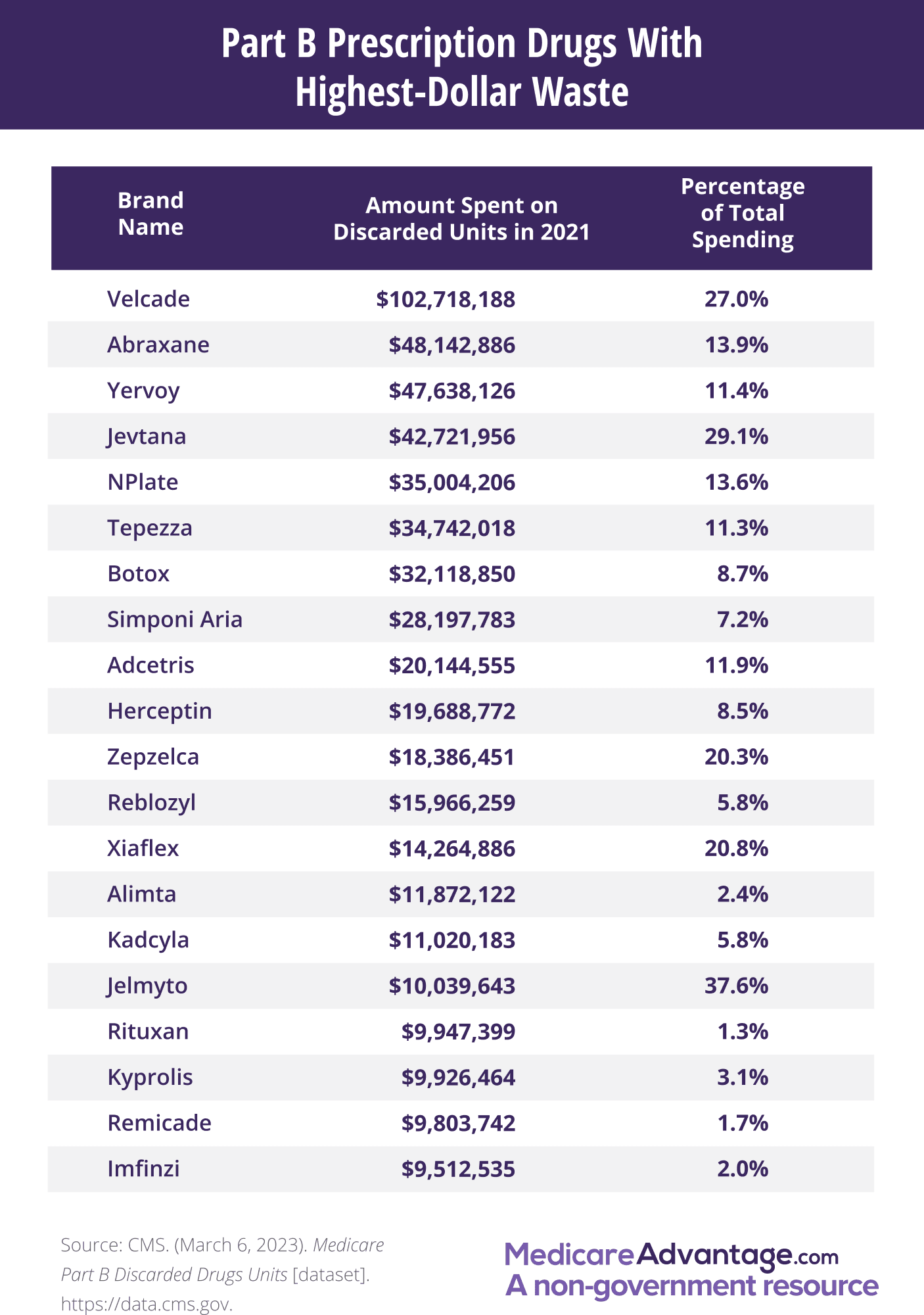Medicare Spent Over $3.6 Billion On Discarded Drugs From 2017 to 2021
Wasted Medicare dollars could be better spent on medication for seniors, women and people with cancer
Updated April 4, 2023
Millions of tax dollars are wasted every year on discarded doses of drugs covered by Medicare. Legislation that took effect in 2023 as part of the Infrastructure Investment and Jobs Act aims to curb Medicare spending on unused medication.
In light of this recent legislation, we examined data from the Centers for Medicare and Medicaid Services (CMS) to see just how much Medicare spending goes to waste every year on unused and discarded doses of medication.
Our analysis of the most recent data provided by the CMS finds that more than $779 million of Medicare spending was wasted on discarded units of drugs in 2021. Medicare has spent more than $3.6 billion on unused medication since 2017.
The majority of this wasted taxpayer money was spent on unused units of chemotherapy and cancer-treating drugs that were thrown away and unavailable for treating other patients in need of the drugs.
Most of this medication and financial waste is due to single-dose vials or containers of medications that include higher doses than are necessary to treat the average patient.
We identified key areas related to cancer treatment, women’s health and general public health that could benefit in drastic ways if given the amounts of money Medicare has wasted on discarded drugs.
Click on image to enlarge in a new tab
Part B Drug Waste Report Key Findings
- Nearly $102 million worth of discarded units of Velcade was charged to and reimbursed by Medicare in 2021. Velcade (Bortezomib) is a cancer-treating drug with 27% of each dose going to waste in 2021, on average. The cost of wasted Velcade was more than twice that of any other drug in 2021.
- More than 67% of the cost of the drug Omnipaque (Iohexol) reimbursed by Medicare in 2021 was lost to discarded doses. Omnipaque is a contrast agent that helps medical providers see organs and blood vessels on an X-ray. The cost to Medicare for these discarded units added up to more than $1.5 million in 2021.
- Medicare wasted at least 20% of its spending per drug on 16 different drugs due to discarded doses that were billed to Medicare. The combined cost of these discarded units was more than $204 million, more than one-quarter of all Medicare Part B drug waste in 2021.
- Medicare reimbursement for 74 different drugs included at least $1 million for discarded doses in 2021.
- Medicare wasted money on discarded units of at least 392 different types of drugs in 2021.
Why Is So Much Money Wasted on Discarded Drugs?
Research suggests that due to the “buy and bill” drug supply model, drug manufacturers are actually incentivized to produce medication quantities that are more likely to wind up discarded when single-dose vials or containers include higher doses than are necessary.
Profits are increased by billing for the whole vial, even if only a portion of it is needed and used. Doctors and hospitals also enjoy bloated profit margins under this system.
Congress passed the Infrastructure Investment and Jobs Act in 2021, which included a provision requiring drug manufacturers to issue refunds to Medicare for discarded drugs above certain spending thresholds.
The law went into effect in January of 2023 and aims to discourage drug manufacturers from packaging their products in a manner that leads to wasted doses.
Valuable Cancer Drugs Are the Most Commonly Discarded and Account for Highest Costs of Waste
Medicare wasted more than $1 million per drug on discarded doses of 76 different drugs in 2021, most of them vital chemotherapy and cancer treatment drugs.
- The four drugs with the highest amounts of waste are all chemotherapy or other cancer treating drugs. The combined waste from these four drugs (Velcade, Abraxane, Yervoy and Jevtana) totaled over $241 million in 2021, or 31% of all Medicare Part B drug waste for the year.
- 29% of all Medicare Part B dollars spent on Jevtana was lost due to discarded doses while more than 27% of the money spent on Velcade was lost.
- Jelmyto (Mitomycin) is used to treat cancer in the urinary tract. For every $1 Medicare spent on Mitomycin in 2021, another 62 cents was wasted on discarded units.
Click on image to enlarge in a new tab
Necessary Women’s Health Treatments Could Have Reached More People With Wasted Funds
The money Medicare wasted on doses of drugs that were thrown away could have covered all or at least large portions of the costs many women face when getting treatment for breast cancer and other conditions.
- Medicare spent over $19 million on discarded dosage units of the breast cancer drug Herceptin. That wasted money could have covered the Medicare costs of an additional 11,881 doses of the drug.
- Medicare similarly wasted over $48 million on discarded units of Abraxane, which is also used to treat breast cancer. That wasted spending is equivalent to 30,703 doses.
- The blood disorder drug Panhematin (Hemin) is used to help women who experience acute porphyria related to their menstrual cycle. Wasted Medicare spending on discarded units of Panhematin totaled more than $1.3 million in 2021.
Putting $779 Million Into Perspective: Opioid Addiction and Other Public Health Needs
To further illustrate the amount of taxpayer money that was wasted on discarded Medicare Part B drugs in 2021, we compiled a list of ways this amount of money could have been put to use for a number of public health issues.
- $779 million would cover the cost of around 40 million flu shots, or nearly two out of every three people on Medicare.1
- Approximately 3.3 million Medicare beneficiaries use insulin to control blood sugar levels.2 Under Medicare’s new insulin cap of $35 per month, the $779 million in Part B drug waste could fully cover the insulin costs of all 3.3 million beneficiaries for more than six months.
- The more than $779 million spent on discarded drugs in 2021 could’ve covered the cost of more than 19 million COVID-19 vaccine doses at the Medicare-approved rate, or enough for nearly one out of every three Medicare beneficiaries.3
- $779 million could cover the cost of a one-year AARP membership for close to 49 million seniors, or roughly three-quarters of the entire Medicare population.4
Click on image to enlarge in a new tab
Conclusion
Although the total amount of Part B spending on discarded drugs is high, it only accounted for less than 2% of total Part B drug spending in 2021.
A part of the Infrastructure Investment and Jobs Act of 2021 has the potential to reduce wasted tax dollars spent on covering the cost of discarded drugs beginning in 2023. We will issue a report in early 2024 examining the 2022 data as soon as it is available.
Data notes
Our analysis is based on data made available through CMS.gov.
We compiled drug spending amounts and beneficiary counts using the 2020 Medicare Part B Drug Spending Dashboard, the 2020 Medicare Part D Drug Spending Dashboard, the 2020 Medicaid Drug Spending Dashboard and the Medicare Part B Discarded Drug Units Reports from 2017 through 2020. These are the most recent data available.
Drug usage was categorized by a drug’s primary use.
Fair Use Statement
Of course we would love for you to share our work with others. We just ask that if you do, please grant us the proper citation with a link to this study so that we may be given credit for our efforts.
Research and Reports
Our research reports analyze a number of issues important to seniors, from health perceptions, medical communication, health habits and more.


